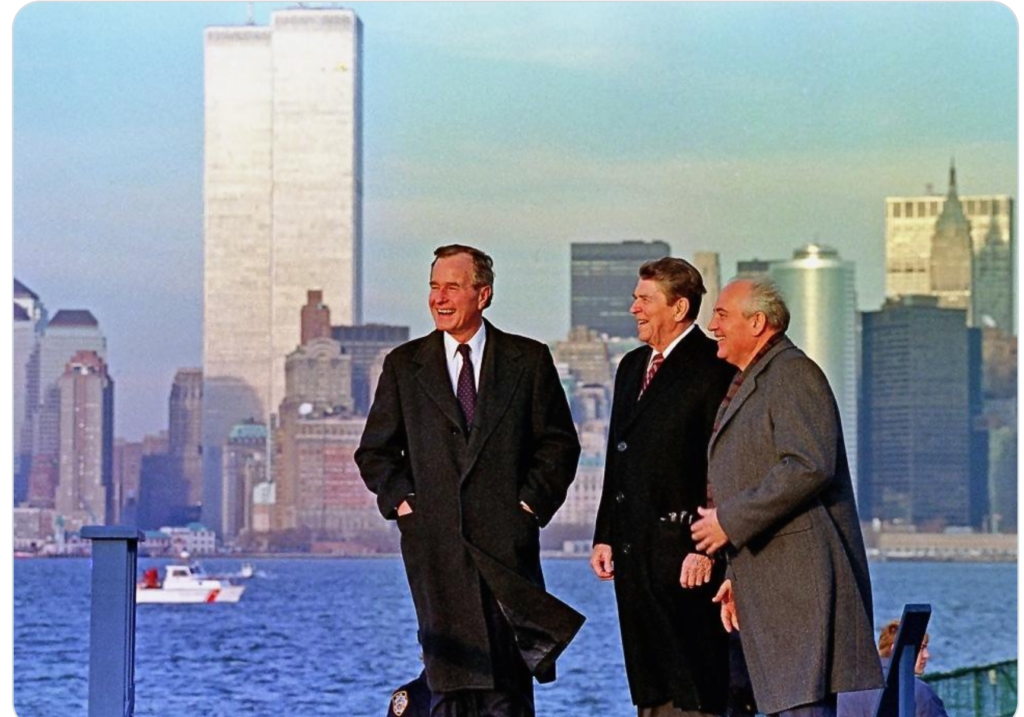
A few months before the fall of Berlin Wall in November of 1989, American political scientist Francis Fukuyama published an essay entitled “The End of History?” Fukuyama’s thesis was that with the impending collapse of Communism in Europe, liberal democracy was now the final form of government for all societies. This theory conformed with the theories of history expressed by the German philosopher Hegel and Karl Marx. Both men defined history as a linear progression from one socioeconomic epoch to another.
I thought about Fukuyama’s essay when I heard about the death of Mikhail Gorbachev, who was the last leader of the Soviet Union, and who presided over its implosion in December of 1991. Like many people who lived through the fall of the Berlin Wall, the reunification of Germany, and the dissolution of the Soviet Union in December 1991, I welcomed the end of the Cold War and its never ending threat of nuclear annihilation. What I failed to understand at the time was that ending of one threat didn’t mean that all other threats went away. I also didn’t understand that no nation can go from a total dictatorship to market oriented freedom overnight, and that the regression to authoritarian rule is extremely easy, as we’re seeing in today’s Russia.
The photo at the top of this post was taken in December of 1988. It shows President-elect George HW Bush, the last of the patrician Rockefeller Republicans, outgoing President Ronald Reagan, and Soviet President Mikhail Gorbachev in New York City. Gorbachev was in the United States for his final summit with Reagan. Bush had just been elected with an overwhelming majority, winning 40 states with 426 Electoral College votes, and he had no idea that he would be America’s last Cold War president. Looming in the background is the World Trade Center.
Whenever I see this photo, I always wonder at what might have been. In less than a year after this picture was taken, the Berlin Wall would come down, ushering in a wave of revolutionary change across what had once been known as the Iron Curtain countries. Czechoslovakia, Hungary, Poland, Bulgaria, and Romania all toppled their communist governments by the end of 1989. By the end of 1991 the Soviet Union itself was gone, leaving the United States as the world’s sole superpower.
In hindsight it’s easy to say that the United States should have led an effort to pull Eastern Europe from the rubble of communism, just as we used the Marshall Plan to pull Western Europe from the rubble of Nazism and the destruction of World War II. While I give President Bush great credit for managing a soft landing from the implosion of communist rule in Europe, I must fault him and his national security team for not realizing that any democracy, especially a brand new one, requires a tremendous amount of care and nurturing if it is to survive, let alone flourish. If there were ever a president who should have understood this it was Bush, who was a veteran of World War II, U.S. Ambassador to the United Nations, the second chief of the U.S. Liaison Office in Beijing (the United States didn’t establish full diplomatic relations with the People’s Republic of China until 1 January, 1979), and CIA director. With those credentials and experience, Bush should have realized that a long term political and financial investment was needed in both Russia and the former Soviet bloc countries if the end of history was truly the destiny of humanity.
The photo of the World Trade Center is chilling, since it shows that it’s the things you never anticipate that produce the real horrors. In December of 1988 the Soviet Union was two months away from terminating its occupation of Afghanistan. Throughout the years the Soviets occupied and fought a counter-insurgency campaign in Afghanistan, the CIA funded and trained the insurgents. One of the insurgent leaders trained by the CIA was Osama bin Laden, who came to Afghanistan because he saw the Soviet invasion as an assault on Islam. In 1990 when the Kingdom of Saudi Arabia okayed the deployment of 50,000 American troops as a protective measure after the Iraqi invasion and annexation of Kuwait, bin Laden viewed the presence of American troops on the soil of the land that holds Mecca as yet another assault on Islam. And the rest, as they say, is history.
Fukuyama was incorrect when he wrote his essay in 1989, which he expanded into a book. We haven’t seen the end of history, but we have seen the same mistakes made over and over by those who fail to learn from history.
